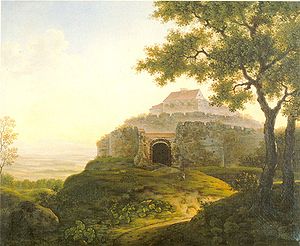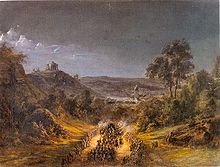Wirtemberg Castle
| Wirtemberg Castle | ||
|---|---|---|
|
Württemberg Castle before 1819 (painting by Franz Xaver Odo Müller) |
||
| Alternative name (s): | Wirdeberch, Werdenberc, Wirtinsberk | |
| Creation time : | 1080 | |
| Castle type : | Hilltop castle | |
| Conservation status: | Burial chapel | |
| Place: | Stuttgart-Rotenberg | |
| Geographical location | 48 ° 46 '55.5 " N , 9 ° 16' 7.2" E | |
| Height: | 411 m | |
|
|
||
The castle Wirtemberg was a hilltop castle and the family seat of Württemberg after the ancestors of Württemberger their first family seat, the castle Beutelsbach , including Castle Kappelberg called, had probably given up. The new castle was built on the Rotenberg (411 m above sea level), an extension of the Schurwald forest between Cannstatt and Esslingen am Neckar on the area of what is now the Rotenberg district of Stuttgart . There were three castles with this name in the period from 1080 to 1819.
Surname
The name of the castle has changed several times over the centuries from "Wirdeberch" to "Werdenberc" and "Wirtinsberk". The spelling "Württemberg" became the official name of the state when Napoleon raised it to the Kingdom of Württemberg . According to legend, this should also counteract the corruption of "host on the mountain".
It was not until May 1803 that the name “Württemberg” was officially used for the entire state for the first time. In 1907, the Rotenberg was officially renamed "Württemberg" by King Wilhelm II of Württemberg .
The presumption, mountain and castle got its name from the in Luxembourg (the possible home of sex lying Württemberger) "Wirdeberg", is considered unlikely as likely today.
Linguists have recently suggested a derivation from the developed Roman- Celtic term “Wirodunum” (-dunum ”=“ fortress ”), which was initially shortened to“ hosts ”and later supplemented with“ -berg ”. This thesis is supported by a number of other, presumably Celtic place names in the vicinity of Cannstatt .
The origin of the name was already considered puzzling in the Middle Ages, and several folk etymological explanations as “will a mountain” or “host on the mountain” were anecdotally supported. The Stuttgart councilor Sebastian Küng († probably 1561) made fun of these attempts in his chronicle:
"Here's again the clever, so fond of something nuis dense worlds, even fought as they wave the name ain ethimologiam, and his ettlich, who say that an emperor passed through this country before, and there he is mountain up, have measured the other one off, he said, one mountain after another ends up in this one; according to this, landt was made with these three little words, Wirt ein Berg, together with Wirteinberg and volgendts Wirtemberg. The emperor must of course never have come to Schweitzerland, then he would have christened the same with that name. "
history
First castle
"A festival with three circular walls , extensive stables and several outbuildings, a beautiful inner courtyard and a stately mansion" , this is how the building from 1080 presented itself , the castle chapel of which was consecrated on February 7, 1083 by Bishop Adalbert II of Worms . The original consecration stone is now in the Russian Orthodox Church of the Holy Sepulcher on the site of the castle and is the earliest documented evidence of the House of Württemberg .
Konrad von Wirtinsberk was named as a witness in a document dated May 2, 1092 . This is the oldest written mention of the name Württemberg . The castle was the seat of the Counts of Wirtembergs several times from 1092 to 1495.
In 1311, Wirtemberg Castle was destroyed for the first time by the neighboring imperial cities under Emperor Heinrich VII .
Second castle
After the destruction in 1311, the castle was rebuilt, albeit smaller than before. This second Wirtemberg castle was destroyed by flames in 1519 when, under the command of Duke Wilhelm of Bavaria, the league of towns occupied almost all of Württemberg.
Third castle
| After it was destroyed in 1519, Duke Ulrich von Württemberg had the ancestral castle of Württemberg built a third time. In 1819 King Wilhelm I had the castle, which had meanwhile fallen into ruins , demolished . |
Burial chapel
From 1820 to 1824 Wilhelm I had a mausoleum ( burial chapel on the Württemberg ) built by Giovanni Salucci in a classical style for his late wife Queen Katharina instead of the castle . This has been open to the public since 1907.
literature
- Albrecht Greule : Celtic place names in Baden-Württemberg. We can do everything - except Latin. In: Archäologisches Landesmuseum Baden-Württemberg (Ed.): Imperium Romanum. Rome's provinces on the Neckar, Rhine and Danube. Exhibition catalog. Esslingen 2005, ISBN 3-8062-1945-1 , pp. 80–84
Web links
Individual evidence
- ^ The chronicle of the Stuttgart councilor Sebastian Küng, ed. v. Ingrid Karin Sommer, Klett, Stuttgart 1971, p. 30
- ↑ Website on the Weihestein der Burg Wirtemberg, with photo that can be enlarged





